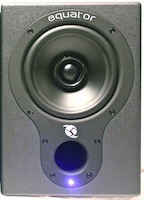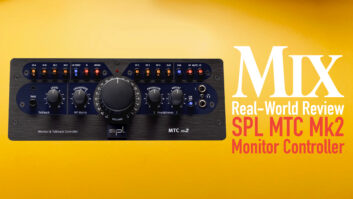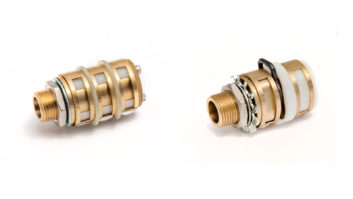
The point-source design of the D5 makes for a wide sweet spot.
Last year I had the pleasure of reviewing Equator Audio’s Q12 monitors for Mix (February 2011) and was impressed with many of their features—most importantly, the sound of those formidable 12-inch coaxial speakers. With the D5, Equator continues its philosophy of point-source sound reproduction, albeit in a greatly reduced footprint, power rating, maximum SPL and price point. Although the D5 is not meant to compete with its bigger brothers, Equator’s design criteria remains consistent: a self-powered, front-ported box with a wide sweet spot and detailed, linear reproduction for $299.99/pair, a price that is nothing short of “stupid-cheap.”
SMALL FOOTPRINT, BIG SOUND
Not too long ago, small speaker designs sounded, well, small and boxy, exhibiting nonlinear reproduction that forced you to guess at how your mixes would sound when translated to other systems. Lately, I’ve been listening to a plethora of well-designed small speakers and came away with the impression that these small-footprint designs are getting better all the time. By using a greater degree of advanced materials, DSP and advanced acoustic-modeling software, the “art of the small box” is rapidly advancing in its design, implementation and detailed reproduction. The D5 sits firmly in that category.

The D5s are only sold online, direct from the factory. This distribution philosophy, along with cost-effective production in China, benefits the end-user by making these speakers affordable for all. And the icing on the cake: They sound good. The speaker’s dimensions (9.75x7x8.5 inches), along with its front-ported design, allow the D5s to be placed in any environment—meter bridge, desktop, OB van or mounted on a wall.
INGREDIENTS IN THE PUNCH
The D5s offer a good sense of tight, punchy low end, down to the rated 53 Hz. The cabinet is physically a bit deeper than some small designs I’ve recently tested, and this increase in cabinet size no doubt contributes to the amount of bass response that the speaker delivers. The D5 employs a 5.25-inch polypropylene low-frequency driver. Equator Audio tuned the 1.75-inch front-extended port for linearity down to the rated response. An onboard digital power amplifier with a 100-watt RMS drives the D5’s woofer and 1-inch-diameter silk tweeter. However, the user manual does not mention how this power is being split between the drivers, nor does it explain the amp’s operational design. The front baffle, as well as the rest of the cabinet, is made of wood, providing rigidity and reduced cabinet resonance; but again, there is no mention of whether the construction is laminate, solid or particleboard.
A fourth-order digital crossover (24dB/octave slope), along with internal DSP, is tuned to deliver less distortion in the critical midrange (900 to 3k Hz) and “matched transducer output.” A small, circular port on the back panel is labeled “For Calibration Only,” and is used exclusively by Equator to tune the speaker. The back panel sports an IEC connector, on/off switch, XLR and ¼-inch TRS inputs, a continuously variable detented sensitivity control (-10 dBV to beyond +4 dBu) and a “boundary control.” This control is simply labeled 1, 2 and 3, corresponding to Corner, Front of a Wall and Free Standing, respectively. Response curves are not provided for these settings, but from listening to the variations, it is apparent that the low-frequency response is rolled off to adjust for the associated build-up of bass amplitude when speakers are placed in a corner or next to a wall. There is limiter and driver protection, as well as thermal and short-circuit protection—all characteristics of a well-thought-out, professional transducer.

The back of the D5 offers simple sensitivity and boundary controls.
LET’S GET SMALL
Because the D5s are coaxial and have a “point-source reference,” they exhibit a wide sweet spot, which means that the soundstage and imaging are anchored securely to the phantom center. This is one of the little speaker’s major features, along with its amazingly linear frequency response in the midrange.
Inevitably, every speaker is going to sound different, so I use several different reference speaker systems for comparison. In doing so, you must give credence to a baseline reference—one that you know and trust. That system, for me, is the JBL LSR-6328P with a JBL-6312P subwoofer. I also reference several smaller speakers, ones that I know and love. With that said, the Equator D5s exhibit a high degree of accuracy and imaging as compared to my reference speakers. Of course, there is going to be a difference: These boxes are much smaller than my references, but I can honestly say that in the critical vocal range, I could rely on the D5s to make mix decisions.
Listening to my reference mixes, the D5’s instrument placement is in line with much higher-priced speakers, and with an SPL rating of 103 dB, I can listen to the characteristics of high-SPL reproduction, and the obvious low-level details, as well. Equator has produced a speaker that everybody will love, whether editing dialog or mixing full-range in a home environment. I was simply blown away when listening to reference mixes I use all the time to test speakers: The D5’s imaging is superb, its sweet spot is wide, the silk tweeter is smooth and the low end truly goes down to 53 Hz. I’m impressed. At this price point, these speakers are nothing short of phenomenal.
Being a guitar player, I am always looking for accurate reproduction of this particular instrument; as a recording engineer, I’m looking for everything—the complex harmonic structure of piano, the bowing of strings and the grind of a Leslie-driven organ. The D5s reproduce the instruments of an orchestra with a great degree of accuracy; the soundstage is correct, as is the instrument placement and timbre. It reproduces drums faithfully, if not at ear-bleeding levels, with the snare and kick firmly planted in the soundstage with no hint of boxiness. The complex harmonics of piano are heard with little if any escalation or resonance of any particular frequency. And vocal reproduction is realistic, which is unheard of in a speaker this size and at this price.
I found them to be smooth across the entire frequency spectrum, and with nary a hint of listening fatigue after hours of production—a welcome experience. If you need more sound pressure, you will need to go with a different speaker, but the D5 is always a speaker you can refer back to, at a lower level. Granted, the lower octave below 53 Hz will need a subwoofer to truly get a feel for “what’s going on in the basement,” but for everything else, the D5s will suffice in a home studio environment or any near-field monitoring situation.
THE LITTLE MONITOR THAT COULD
Equator has chosen to self-distribute a well-designed little monitor to further its brand name in the industry, and the company has done a remarkable job of creating a system that would fit comfortably in every home studio and professional environment around the globe. A point-source reference monitor, with this degree of accuracy, and at this price point, is a newfound paradigm. This is a no-brainer: Buy these speakers. You will not be disappointed. To ensure this statement, Equator has a 60-day, money-back guarantee. If you don’t like them, send them back. No manufacturer has offered this amount of confidence in its product in recent memory.
Speakers are getting better, and the D5s are at the forefront of this technological trend.
Bobby Frasier is an audio engineer, educator and guitarist for Beatles tribute band Marmalade Skies.

Click on the Product Summary box above to view the Equator D5 product page.







